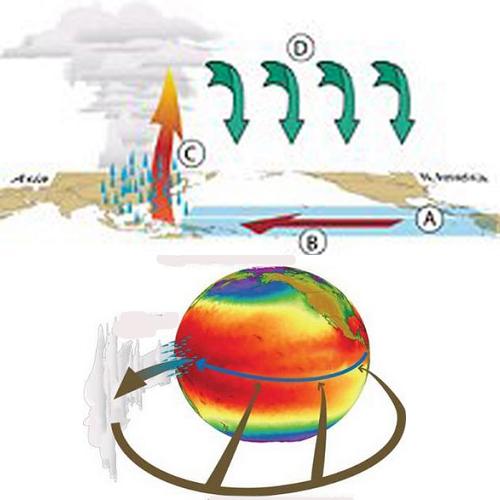The effect of global warming on the flow of water in the Atlantic Ocean has already been written and discussed. Now research data is being published showing how warming will affect wind gusts in the Pacific Ocean.

The effect of global warming on the flow of water in the Atlantic Ocean has already been written and discussed. Now research data is being published showing how warming will affect wind gusts in the Pacific Ocean.
The person who studied the winds of the Pacific Ocean was a climatologist named Walker and named after him - "Walker cycles". Walker defined the directions and times of the winds and the causes of the cycles of what has always been known as the "trade winds", since already in ancient times sailors/merchants knew how to plan their journey in the ocean according to the seasons and the directions of the winds.
Walker described a "pathway" at high altitude, above the tropical region of the Pacific Ocean, where dry air moves from Asia eastward towards South America. On the coasts of South America, the air current sinks and creates a "path" of moist air close to the surface of the water that moves in a westerly direction, (and drives the trade winds). When the moist air reaches SE Asia it causes rain in Indonesia, the air warms up, dries up, rises and turns east again.
Now it is possible that Walker or another researcher will have to repeat the study and update it since due to global warming the Walker cycle is affected. Measuring the speed of the Walker circulation shows that in recent decades the wind speed has decreased by 3.5%, a decrease that was predicted in computer models and measured starting in the middle of the twentieth century,
Because of the contiguity between global warming and the decrease in wind speed, people tend to link the phenomena and assume that it was the warming that had a direct effect, and therefore the wind speed will continue to decrease. Every few years, for reasons that are not clear, an ocean current that comes from Antarctica moves and approaches the coast, it is assumed that this change is affected
and affects (reciprocally) the Walker cycle. One of the more well-known and famous results of this change is the "El Niño" during which torrential rains fall in South America on the one hand and on the other hand areas in Asia, Australia and Africa suffer from dryness and drought.
It is not clear what climatic effects the decrease in speed will have, but from what is known, the effect of a slowdown in the Walker cycle will cause phenomena similar to "El Niño", meaning more rain in South America, dryness and drought in Australia and in large parts of Africa and Asia.
Elsewhere I referred to the changes (slowing down) in the oceanic currents. Since the Walker circulation has an effect, even if bypassed, on the ocean currents, the assumption is that slowing the Walker circulation will cause a further slowdown in the ocean current, resulting in a significant decrease in the amount of food in the water and further damage to the marine environment. A slowdown in the wind flow may cause a reduction in the plankton and phytoplankton near the western coasts of Africa and as an immediate result, a decrease in the quantities of fish prey, which millions of coastal residents rely on.
In the Indian Ocean, there are still sailing ships - DHU - whose captains schedule their journeys according to the trade winds, and indeed the influence mentioned above is not so extreme in the Indian Ocean. In the Pacific Ocean, the trade winds are no longer a driving factor for the movement of ships, so it is possible that there will be those who say that they are not important and it is not.
